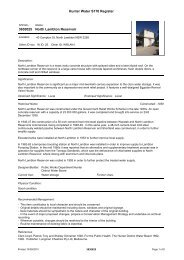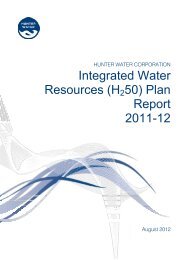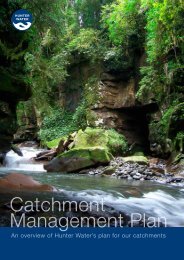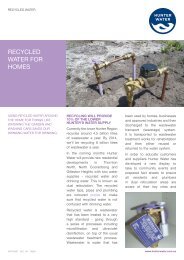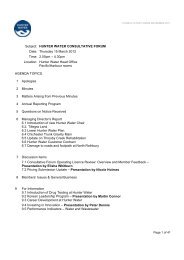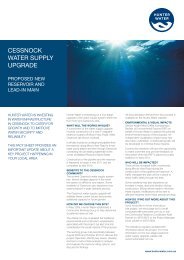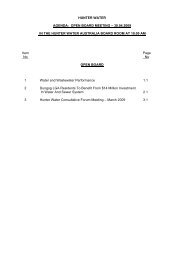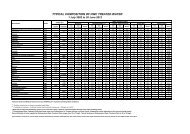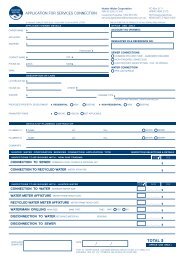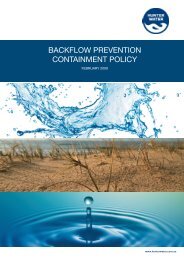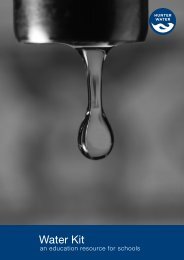Catchment Management Plan - Hunter Water
Catchment Management Plan - Hunter Water
Catchment Management Plan - Hunter Water
You also want an ePaper? Increase the reach of your titles
YUMPU automatically turns print PDFs into web optimized ePapers that Google loves.
Freudenberg (1999) 9 recommendsthe construction of a comprehensive‘stakeholder map’ with consideration ofstakeholders as varied as governmentorganisations, industry representatives,consumer groups, recreational groups,non-government organisation, residentsand traditional owners. The paper arguesthat there is a great deal of expertiseand goodwill in catchments outside ofauthorities and that inclusion of a broaderrange of stakeholders ultimately leads tobetter decision making. It suggests thatthis information can be collected throughworkshops or surveys. It is noted thata detailed map can take a considerabletime to construct.3.3.3 Current stakeholderrelationships<strong>Hunter</strong> <strong>Water</strong>’s specific relationships incatchments have been built over manyyears. We are currently represented onthe following diverse range of committeesin catchments:• National Parks and the NSWDepartment of Defence: Currentquarterly meeting to discussland use issues. A MoU isunder negotiation to delineateresponsibilities.• Lower <strong>Hunter</strong> and Port StephensBushfire <strong>Management</strong> Committee:Meet quarterly, almost $100 000 wasspent on fire trails and clearing lastfinancial year 10 .• Feral animal control committee:Aim to control feral animals. Annualmeeting.• Port Stephens Council Koalacommittee: Quarterly, supportingthe Port Stephens Koala <strong>Plan</strong> of<strong>Management</strong>.• Medowie flood managementcommittee: Aim to resolve floodingissues in Medowie.• Ranger patrols and presence buildsland owner relationships.• Regional weeds committee: Aim toidentify and eradicate problem weedareas. <strong>Hunter</strong> <strong>Water</strong> spent $18,000on weeds removal in catchments lastfinancial year.• Grahamstown Dam Recreational<strong>Plan</strong> of <strong>Management</strong> Committee:Aim to manage recreation inGrahamstown Dam.• <strong>Hunter</strong> Central Coast Illegal DumpingGroup: Aim to identify and combatillegal dumping. Meet quarterly.• <strong>Hunter</strong> Illegal Trail Bike Riding Group:Aim to identify and combat areas ofillegal trail bike use. Meet quarterly.• Landcare and Tocal Field Dayssponsorship: Yearly grants, $15,000for small Landcare grants and$10,000 for the Field Days.3.3.4 Recent improvementsin relationships withstakeholders• The <strong>Hunter</strong> <strong>Water</strong> <strong>Catchment</strong>Committee: <strong>Hunter</strong> <strong>Water</strong> convenesa quarterly internal <strong>Catchment</strong>Committee with a diversity ofplanners and operational staff inattendance. This committee hasbeen operational for 18 months withpositive feedback. The committee isa knowledge centre and promotesdiscussion of:• Developments and developmentapplications in catchments to bediscussed;• Rangers to give an ‘on ground’perspective of the catchments;• Land use changes to beanalysed;• <strong>Hunter</strong> <strong>Water</strong>’s own catchmentobligations to be discussed.• Building partnerships with localcouncils: <strong>Hunter</strong> <strong>Water</strong> recentlyorganised a <strong>Water</strong> Sensitive Citiesforum to which various councilrepresentatives were invited. Anexpert was asked to attend fromMelbourne <strong>Water</strong>, who are oftenseen as national leaders in totalcatchment management. There wasbroad agreement reached that the<strong>Hunter</strong> needs to champion watersensitive urban design and anothermeeting was agreed upon to discusshow we might make this a reality.• Partnering with Landcare and<strong>Hunter</strong> Councils Environmentdivision to apply for federalfunding for our catchments:<strong>Hunter</strong> <strong>Water</strong> and other catchmentstakeholders collaborated to applyfor a federal government grant toimprove the Williams River in 2009.Although the funding opportunitydid not arise, <strong>Hunter</strong> <strong>Water</strong>’swillingness to seek external fundingfor catchment activities was receivedpositively in the region.• Collaboration with NSW Office of<strong>Water</strong>: <strong>Hunter</strong> <strong>Water</strong> has regularmeetings with NOW and hasrecently given tours of catchments,dams and treatment plants. Suchinteraction will likely translateto a better understanding of thewater supply system and buildrelationships in the long term.9 Freudenberg, 1999. Tools for understanding the socioeconomic and political settings for environmental decision making. In Tools to aid environmental decision making, New York.10 Source: <strong>Hunter</strong> <strong>Water</strong> Annual Operating Licence Report: The <strong>Catchment</strong> Report 2008-2009CATCHMENT MANAGEMENT PLAN . ssS . 001 . JUNE201033




